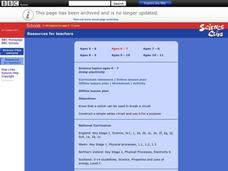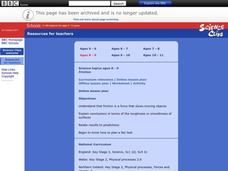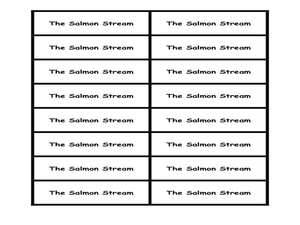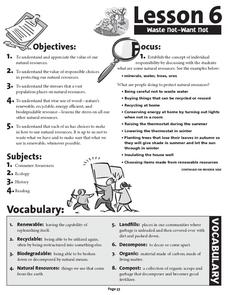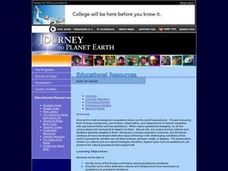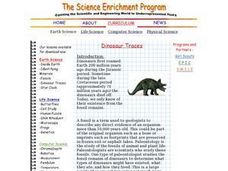Curated OER
Ourselves
Students identify the main parts of the human body. They point to various parts of their own body, cut out pictures of humans and animals and sort them into the two categories, discuss the differences between animals and humans, and...
Curated OER
Food Chains
Fourth graders study food chains, producers, consumers, and decomposers. They play a food chain game and create food chain mobiles or posters. They take a nature hike around the school and observe various parts of a food chain.
Curated OER
Habitats
Students complete food chains for organisms in three environments. They use copies of the Habitat worksheet. Students review the food chain terms with the teacher. They research related food chains, and interlink these to form a food...
Curated OER
Micro-Organisms
Students investigate micro-organisms with an on line activity. For this micro-organism on line lesson plan, students identify bacteria, viruses and fungi projected onto a white board. Students work in groups and use a computer and an on...
Curated OER
Forces in Action
Learners investigate questions centered around force and motion by going through the scientific process and creating fair tests and experimentation. In this lesson about forces-in-action, students diagram their findings and explore other...
Curated OER
Reversible and irreversible changes
Students experiment with solids and liquids to find which solids will dissolve in water. This dissolution and mixtures lesson can be completed online or in class as all materials are connected to the lesson plan for both settings.
Curated OER
Using Electricity
Students read The Lighthouse Keeper's Lunch to become familiar with the way a lighthouse works.In this using electricity lesson, student create lighthouses with plasticine clay and a working circuit. Students complete a worksheet on...
Curated OER
Sorting and Using Materials
Students explore materials and their properties. In this matter lesson, students identify objects and describe their properties. Students test and sort materials using an interactive whiteboard, followed by a group discussion of what was...
Curated OER
Friction
Learners compare and contrast the movement of objects on different surfaces, experimenting with friction and forces of motion. This friction lesson has numerous online tools including worksheets and virtual activities; the option is also...
Curated OER
Jack and the Beanstalk
Third graders read a story and grow a beanstalk. In this literature and life science lesson, the class reads "Jack and the Beanstalk," then lists fairy tale elements and write a puppet show. The students plant pinto beans and observes...
Curated OER
How We See Things
Students investigate how mirrors reflect light. In this reflection lesson, students draw the path of the light reflected from a mirror. Students construct a list of objects that are light sources.
Curated OER
A Wild Chain Reaction
Learners explore habitats. In this habitat lesson, students break into groups and are labeled as a part of a habitat. Learners then do an activity with yarn that shows how all of the parts are connected and depend on each...
Curated OER
The Salmon Stream and Vegetation
Students explore the ecosystem and food chain by researching Pacific Salmon. For this fish habitat lesson, students discover the life cycle for salmon, where they spawn and what they eat to survive the harsh elements. Students...
Curated OER
Waste Not Want Not
Learners are introduced to the need to save natural resources. Through inquiry, hands-on activities, and problem solving, students increase their understanding of solid waste materials and the need to reduce, recycle, and reuse.
Curated OER
Seas of Grass
Students view a video clip about grasslands. They identify threats to grasslands and describe cultures which have adapted to grassland conditions. They discuss possible solutions to preserve grasslands as well.
Curated OER
Dinosaur Traces
Learners identify and interpret the type of evidence found at a typical dinosaur dig and mimic a paleontologist by taking crayon rubbings of simulated bone impressions. After the rubbings are taken, the students reconstruct the complete...
Curated OER
Composting
In this recognizing items that can be composted worksheet, students identify organic items that can be composted, write items that can be composted for each of the letters in the word compost, and make a list of vegetables and fruits....
Curated OER
Amazing Grazing: Keeping Our Ecosystem Running
Students discover the value of sustainability within our ecosystem. In this ecological instructional activity, students discuss the importance of a food cycle in our society, and how humans can improve the conservation of a healthy...
Curated OER
"Web of Life" Game
Students relate members of an ecosystem by their interactions. In this ecosystem lesson, students toss a ball to other members of their group (each representing a member of an ecosystem) and tell how they are related to that member....
Curated OER
Three Clouds Activity
Students understand how clouds are formed. In this cloud activity, students participate in three experiments to make clouds. Students complete activity sheets for each experiment.
Curated OER
Disposable Diaper Comparison and Mystery Powder Identification
Students investigate which diaper is the most absorbent. In this chemistry instructional activity, students calculate how much water is absorbed by diapers. They identify an unknown powder based on physical and chemical properties.
Curated OER
Forest In A Jar
Tenth graders are introduced to the process of succession and gain awareness of the changing nature of ecosystems. They demonstrate a comprehension of the dynamic nature of ecosystems, including the relationship between ecological...
Curated OER
Lesson 12: Ho'olaulima: Let's Make a Hawaiian Garden
Second graders grow a classroom garden that acts as a living laboratory for cross-curricular activities. In this classroom garden lesson, 2nd graders follow directions to build and plant a garden that is used to teach math, science, and...
Curated OER
Animals and Their Biomes
Students categorize animals according to their natural biomes using biome and animal flashcards.
Other popular searches
- Plants and Soil Erosion
- Growing Plants Without Soil
- Soil Plants
- Growing Plants Without Soil.
- Plants Soil Bogs
- Can Plants Grow Without Soil
- Soil and Plants
- Science Plants and Soils






